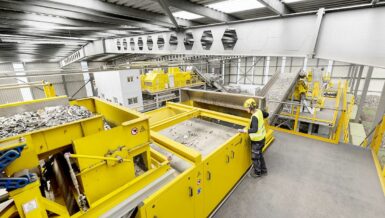The proportions of free magnesium (Mg) contained in the material flow of some scrap aluminum can now be reduced by up to 92%. This technical application can be retrofitted on most STEINERT XSS T x-ray transmission sorting systems built from 2016 and is already being used.
The dry mechanical processing of scrap aluminum involves multiple sorting stages to extract ferrous proportions via magnetic separation and non-ferrous metals (such as waste and composites) via an eddy current separator. Free heavy metals and high-alloy aluminum objects (with high proportions of copper and zinc) are separated using x-ray transmission (XRT) sorting systems. If required, these can also separate significant amounts of wrought and cast aluminum in a separate sorting stage to generate added value from the proportions of coveted clean wrought.
A breakthrough for the “magnesium reduction” sorting task

Within the STEINERT XSS T sorting stages, further technical advancement in the x-ray sorters can now further improve the aluminum quality. This enables the proportions of free magnesium contained in the material flow of some scrap aluminum to be reduced by up to 92%. The magnesium (die-cast components) can either be extracted separately as a concentrate or can be sorted, for example into the cast aluminum fraction – the technology available until now meant that both were barely feasible with STEINERT XSS T.
This application can now be integrated into aluminum scrap sorting systems (ELV, mixed scrap) and operates at the usual throughputs of 3 to 8 t/h per meter of sorting machine width. It can, therefore, be used without any loss of throughput capacity. This sorting task can now be performed in the usual grain sizes and process lines of 10 – 30 mm, 30 – 70 mm and 70 – 130 mm because that is also where the main share of free magnesium is found. In the case of machines built from 2016 onwards, STEINERT can retrofit the sorting program at the customer’s premises.
It can also be used with STEINERT KSS FL XT combination sorters
Controlling the proportions of magnesium in the aluminum fractions is vital, especially in the trading and technical processing of scrap aluminum in secondary melting plants. The STEINERT KSS FL XT (multi-sensor technology), with additional sensors for detecting further object characteristics, also has an improved ability to manage this sorting task even with complex input materials. The STEINERT Metal Recycling Experts are available for further inquiries.

























